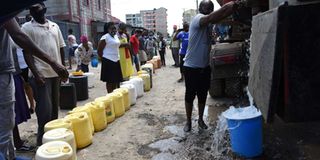Let’s seek water solutions, save the vulnerable

Residents of Umoja estate in Nairobi queue to fill their jerricans with free water that was distributed by the Sonko Rescue Team on May 14, 2020.
What you need to know:
- 32 per cent of Kenyans rely on unimproved water sources, such as ponds, shallow wells and rivers.
- Kenya has the third-largest number of people in Sub-Saharan Africa who drink directly from contaminated surface water sources.
The Covid-19 pandemic has starkly illustrated how multiple water security risks affect the lives and livelihoods of millions of people across Africa, Kenya included.
It has compounded the severity of the impact of water-related climate hazards like floods, droughts and cyclones.
The government has set January as the return date to school for all children,10 months after they were shut to help curb the rising cases of Covid-19.
That will come with serious challenges as the schools will need a constant supply of water to ensure students, teachers and non-teaching staff have access to water for drinking and hand washing.
Now more than ever, access to safe water is critical to the health of families so they can protect themselves from the coronavirus and other diseases.
Unfortunately, water remains one of the scarcest commodities in Kenya. This is a critical time in our generation where we recognise water insecurity as a major threat to millions of children living with unacceptable water, sanitation and hygiene services at home, in schools and healthcare facilities.
Among the population of 50 million, 32 per cent of Kenyans rely on unimproved water sources, such as ponds, shallow wells and rivers while 48 per cent lack access to basic sanitation solutions.
These challenges are especially evident in rural areas and urban slums. A Unicef report shows Kenya has the third-largest number of people (approximately 10 million) in Sub-Saharan Africa who drink directly from contaminated surface water sources.
The country’s natural water resources also do not provide an equitable delivery of water to the various regions. And its water basins do not reach the whole country equally.
Rapid urbanisation has also pushed poor urban dwellers to the slums, where there is no water or sanitation, and overcrowding exacerbates the hazardous health conditions.
Ensuring water infrastructure functions with affordable, reliable and safe services in these complex environments in times of crises is critical to protect vulnerable individuals, communities, schools and healthcare facilities.
Building water infrastructure reduces the need for, and the cost of, emergency funding to avoid unnecessary hardship on the most vulnerable resources and increases resilience to future risks and shocks.
Kenya has a comprehensive regulatory and institutional framework for water resource management as well as water and sanitation service delivery, underpinned by the 2002 Water Act.
Plans for river basin development — encompassing projects in water-related sectors such as energy and irrigation — are laid out in the National Water Master Plan (NWMP) 2030. Other solutions, like borehole wells and rainwater harvesting tanks, are also needed in urban and peri-urban areas.
Let’s focus on setting up the right infrastructure for water security to improve the health of the nation. So, in the new year, focus should be on how to ensure the populace has access to clean water.
Mr Thomas is an international consultant and board member of Megapipes Solutions Ltd.





